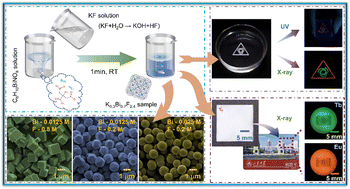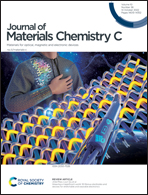Self-surfactant room-temperature synthesis of morphology-controlled K0.3Bi0.7F2.4 nanoscintillators†
Abstract
Bismuth-based fluoride nanocrystalline materials are becoming an emerging class of host matrixes for luminescent lanthanide ions (Ln3+). However, the synthesis of morphology-controlled bismuth-based fluoride nanocrystals still remains a challenging work. Herein we report an aqueous-phase self-surfactant route to synthesize the K0.3Bi0.7F2.4 (KBF) nanocrystalline particles with controllable morphologies in 1 minute at room temperature. It is found that the morphology of the prepared sample is strongly dependent on the contents of ammonium bismuth citrate and KF in the reaction system, leading to monodisperse nanocrystalline particles with uniform cubic, polyhedral and spherical shapes. By introducing Ln3+ (Ln = Tb, Eu) ions into the KBF lattice, the resultant KBF:Tb and KBF:Eu nanoscintillators exhibit fascinating ability to emit intense green and orange-red luminescence upon X-ray excitation. The detection limits of X-ray dose rate are determined to be 1.24 μGy s−1 for KBF:Tb and 0.77 μGy s−1 for KBF:Eu, respectively, which are both lower than the dose rate required for X-ray diagnostics (5.5 μGy s−1). Flexible and large-area scintillator films by incorporating the KBF:Tb and KBF:Eu nanoscintillators into PDMS demonstrate great potential for X-ray imaging applications, which enables them to be promising alternatives for single-crystal and ceramic scintillators.



 Please wait while we load your content...
Please wait while we load your content...